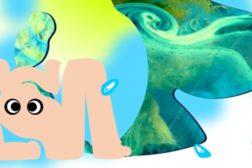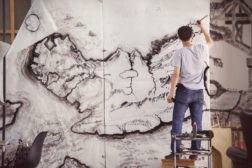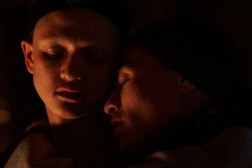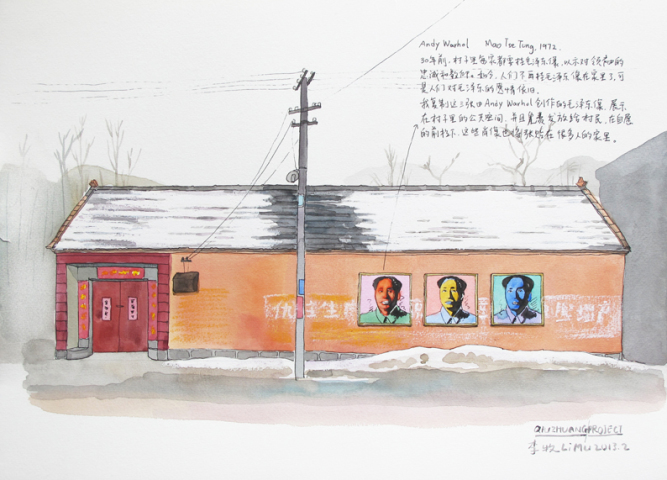

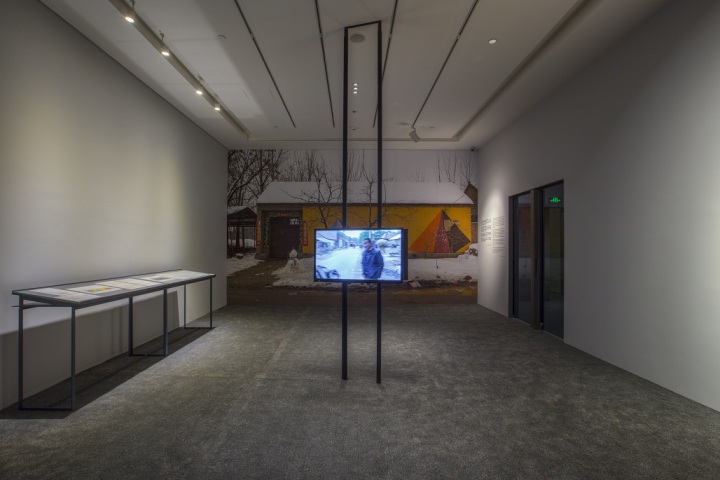
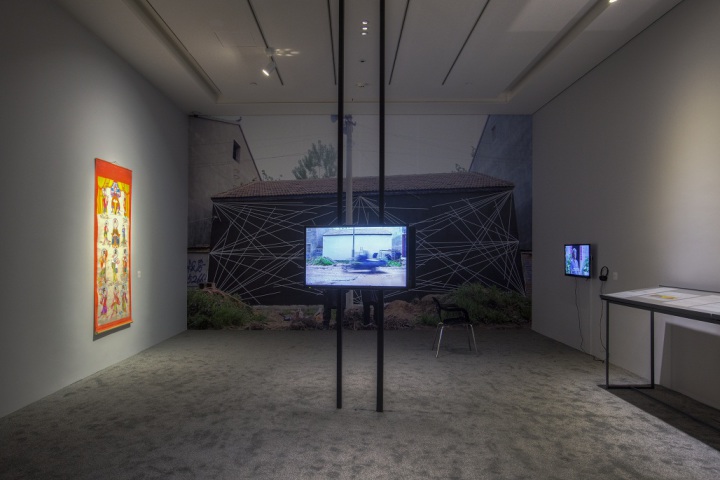
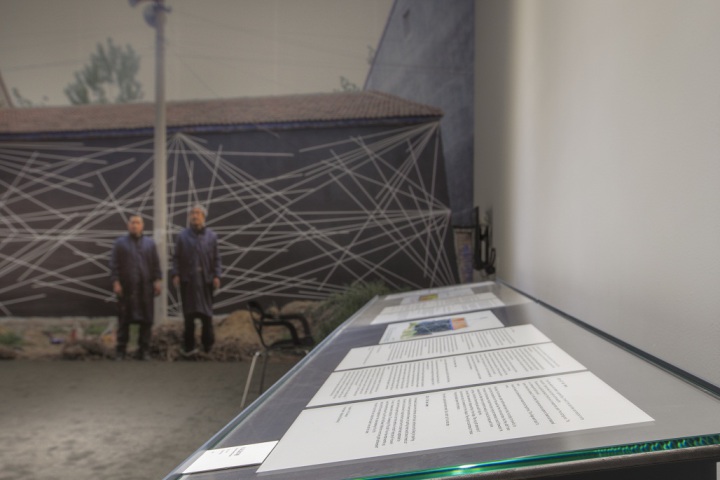
Qiuzhuang Project, Sol LeWitt and Lu Daode
Opening: 5 to 8:30, 19 June, 2015
Exhibition: 20 June to 2 August, 2015
Text written by Davide Quadrio and Charles Esche
It does not happen very often in contemporary art to have the luxury of working on a project for over 5 years from its first inception. Qiuzhuang Project has a very interesting birth and an even more intriguing development from our first contact with Li Mu in 2009. At that time, we were working with Defne Ayas on a project for the Expo 2010 in Shanghai. An exhibition that wanted to bring over the Van Abbemuseum’s collection to Shanghai, but hoped to do so in an unorthodox way.
We wanted to “expose” the collection to the Chinese art world (an audiences tout court), through a process of selection and then of evaluation and curatorial study we hoped to “translate” the works from another context. In this sense, the challenges that this project—called Double Infinity—created, pushed the western museum into an unexplored and complex reality of “fragility” that required the museum to go out of its comfort zone and play with a dangerous situation.
A number of artists from China accepted the challenge and created at hoc works, which transforming the artworks of the Van Abbemuseum’s collection and, in the end, transformative for the artists involved as well.
In this context, Li Mu further complicated the Doubly Infinity project. His work of art was to transform himself into a tool for the “other party”: he became a “worker”, an assistant hired by Van Abbemuseum for the exhibition. His intention was to be become a part of the project’s “translation,” as a testimony to the process of the entire venture. He worked throughout the exhibition’s installation and remained at the museum everyday for as long as the exhibition was ongoing. He collected information, interviews, impressions, poems and drawings, which were all later presented in a small installation for the show at the Van Abbemuseum called Gate Keepers at Play.
At that time, during an interview I conducted with the artist , Li Mu said:
If by communication, you mean showing the collection of a European art museum to ordinary people in Shanghai, it would have been quite superficial. The true communication should be an equal dialogue with mutual influence. I explained the works to the actual audience and exchanged views on art in the exhibition hall every day that the Double Infinity show ran. Such a way of communicating made me very happy, since conversation became the window for mutual understanding. Art is no more than a medium, which facilitates the spiritual communication between artists and the audience and the mutual impact on each other. This makes me realize that in my future work, I should come out of the studio and allow my works to permeate into everyday life.
What happened next is actually how Li Mu was able to take his project to another level. After a residency of a few weeks in the Van Abbemuseum he decided to challenge himself and his practice; the artist exposed himself as a translator again, but not as an artist in the artworld, but rather as an artist back in his country village. At the beginning of this project, Li Mu went back to the village, bringing with him the desire of proposing the “artistic act” of creation, as a way to translate contemporary art into a universal act of empowerment. At that time he commented in the press release:
With the ‘Qiuzhuang Project’, Li Mu wants to explain to his family and relatives what he does and what art could bring to the people from his hometown. Classical modernist works might seem far from the experience of this new art audience and Li Mu is recording how they respond and what happens to the works in this new environment. Do they stay as art in our sense or do they take on different capacities and values. Li Mu also seeks to explore the history of his village, since it is rather blur and no documentation before 1900 can be found. The history has never been recorded in writing, simply since no one ever cared about it, nor about the future. As today’s life is changing in rural China, Li Mu wants to retrieve the history of his hometown and make it available in his library and to the villagers, hoping it will trigger new ways of thinking in the people.
The exhibition in Aurora Museum will bring a complete presentation of this project and all that was found and not found, including all critical considerations that Li Mu has been through during his research for the seemingly impossible dialogue of his project and the Qiuzhuang village. The exhibition will show how the project has transformed and how the journey that Li Mu started more than five years ago is now about to conclude and be presented in all its complexity here in Shanghai, before traveling back to the Van Abbemuseum in the Netherlands.
The show in Aurora is named after two artists, both of whom had a critical contribution to the project—Sol LeWitt and Lu Daode, the village artist who was in constant communication with Li Mu during the process or “reconstruction” of the Van Abbemuseum’s collection in the village.
The exhibition conveys Li Mu’s amazing journey to the audience, the contradictions and the fatigue, the beauty and the utter desperation that Li Mu encountered in realizing this project within his village: from the art library he opened for the villagers to the installations and wall paintings exhibited throughout the year throughout the public spaces of the village.
The show in Aurora’s project room and theatre will present for the first time extensive documentation of this project and all the amazing material collected and produced, including a 4 part film that shows the year long project and Li Mu’s life at the end of this exploration
This exhibition is part of Aurora’s year long project that presents the museum as a Movi(e)ing Museum. The art film split into 4 parts will be shown at the museum theatre and the project room will be where all the chapters of this complex project come together. This exhibition is a collaboration with the Van Abbemuseum, and reiterates Aurora Museum’s long term goal of building an international network with Museums and organizations around the world. Included in this network are institutions that Aurora Museum has already collaborated with, such as the Fondazione Querini Stampalia in Venice and organizations they will be working with in 2015, including the Toronto Film Festival, Canada and Pac, Contemporary Art Museum, Milan.
For a full interview with Li Mu, conducted by curator Davide Quadrio read here.
For more information about the opening see Aurora’s website here.
Full schedule for opening:
Press Conference: 5 to 5:30
Artist and Curator Interview: 5:30 to 6:00
Documentary Screening (Introduction plus Part 1) of Qiuzhuang Log: 7:00 to 8:30
